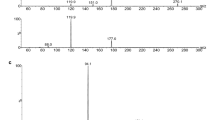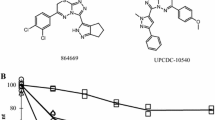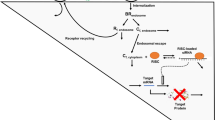Abstract
Purpose
There is currently much interest in developing analogues of the benzoquinone ansamycin geldanamycin that may overcome the limitations of 17-(allylamino)-17-demethoxygeldanamycin (17AAG), which is the first known inhibitor of heat shock protein 90 (Hsp90) to enter clinical trials. Studies were performed to assess whether cassette dosing, the coadministration of several compounds to a single animal, is a suitable approach to evaluate the preclinical pharmacokinetics of geldanamycin analogues in high throughput.
Methods
Five geldanamycin analogues (17AAG, NSC 255110, NSC 682300, NSC 683661, NSC 683663) were administered intravenously to mice in combination at 5 mg/kg each and as single agents at 5 mg/kg and 50 mg/kg, or 12.5 mg/kg for NSC 682300. The compounds were also incubated with mouse liver microsomes individually and in combination at 15 μM each. Quantitative analysis was performed by LC/MS/MS. Plasma and tissue pharmacokinetic parameters were evaluated by non-compartmental analysis. In vitro metabolic stability was assessed by monitoring disappearance of the parent compound.
Results
Of the compounds that were detectable following individual administration at 5 mg/kg, 17AAG and NSC 683661 exhibited nonlinear pharmacokinetics. In addition, the plasma area under the curve (AUC) and the half-life of these compounds was greater following cassette dosing at 5 mg/kg compared to single administration at the same dose. When pharmacokinetic parameters were calculated up to the same time point following cassette and individual administration at the higher dose, three of the compounds displayed non-linear increases in AUC and slower clearances following cassette compared to single compound dosing. When all measurable concentrations at the higher dose were included, the half-life of NSC 683663 was nine-fold longer following individual compared to cassette administration. 17AAG displayed the highest AUC following cassette dosing, whereas NSC 683663 displayed the highest AUC following single-compound dosing. Excluding NSC 683663, the rank order from the highest to the lowest AUC was the same; however, NSC 682300, which ranked fifth, was administered at a four-fold lower individual dose than the other compounds. Exposure of the liver and kidneys to the compounds was greater than that of plasma. Despite being administered at a lower dose, NSC 682300 displayed the highest kidney AUC of the five compounds. The same ranking was maintained between cassette and single compound dosing in the kidney. With the exception of NSC 682300, in vitro metabolic stability was predictive of in vivo pharmacokinetics in the plasma and liver. The extent of metabolism of four of the five compounds was lower following microsomal incubation in combination compared to incubation alone, suggestive of likely drug-drug interaction in the cassette. However, for 17AAG this may be partly due to metabolism of NSC 683661 and NSC 683663 to this compound.
Conclusions
Whilst cassette dosing has advantages for use in drug discovery, it is probably unsuitable to evaluate the pharmacokinetics of geldanamycin analogues due to non-linear pharmacokinetics and drug-drug interaction. The issues identified for this compound series should also be considered in assessing the suitability of cassette dosing for other chemotypes.








Similar content being viewed by others
References
Bailer AJ (1988) Testing for the equality of area under the curves when using destructive measurement techniques. J Pharmacokinet Biopharm 16:303
Banerji U, O’Donnell A, Scurr M, Benson C, Brock C, Hanwell J, Stapleton S, Raynaud F, Simmons L, Turner A, Walton M, Workman P, Judson I (2002) A pharmacokinetically (PK)–pharmacodynamically (PD) driven phase I trial of the HSP90 molecular chaperone inhibitor 17-allylamino 17-demethoxygeldanamycin (17AAG). Proc Am Assoc Cancer Res 43:1352
Banerji U, Judson I, Workman P (2003) The clinical applications of heat shock protein inhibitors in cancer—present and future. Curr Cancer Drug Targets 3:385
Bayliss MK, Frick LW (1999) High-throughput pharmacokinetics: cassette dosing. Curr Opin Drug Discov Devel 2:20
Berman J, Halm K, Adkison K, Shaffer J (1997) Simultaneous pharmacokinetic screening of a mixture of compounds in the dog using API LC/MS/MS analysis for increased throughput. J Med Chem 40(6):827
Brunton VG, Steele G, Lewis AD, Workman P (1998) Geldanamycin-induced cytotoxicity in human colon-cancer cell lines: evidence against the involvement of c-Src or DT-diaphorase. Cancer Chemother Pharmacol 41:417
Egorin MJ, Rosen DM, Wolff JH, Callery PS, Musser SM, Eiseman JL (1998) Metabolism of 17-(allylamino)-17-demethoxygeldanamycin (NSC 330507) by murine and human hepatic preparations. Cancer Res 58:2385
Egorin MJ, Zuhowski EG, Rosen DM, Sentz DL, Covey JM, Eiseman JL (2001) Plasma pharmacokinetics and tissue distribution of 17-(allylamino)-17-demethoxygeldanamycin (NSC 330507) in CD2F1 mice1. Cancer Chemother Pharmacol 47:291
Egorin MJ, Lagattuta TF, Hamburger DR, Covey JM, White KD, Musser SM, Eiseman JL (2002) Pharmacokinetics, tissue distribution, and metabolism of 17-(dimethylaminoethylamino)-17-demethoxygeldanamycin (NSC 707545) in CD2F1 mice and Fischer 344 rats. Cancer Chemother Pharmacol 49:7
Erlichman C, Toft D, Reid J (2001) A phase I trial of 17-allyl-amino-geldanamycin in patients with advanced cancer. Proc Am Assoc Cancer Res 42:4474
Hostein I, Robertson D, DiStefano F, Workman P, Clarke PA (2001) Inhibition of signal transduction by the Hsp90 inhibitor 17-allylamino-17-demethoxygeldanamycin results in cytostasis and apoptosis. Cancer Res 61:4003
Kelland LR, Sharp SY, Rogers PM, Myers TG, Workman P (1999) DT-diaphorase expression and tumor cell sensitivity to 17-allylamino-17-demethoxygeldanamycin, an inhibitor of heat shock protein 90. J Natl Cancer Inst 91:1940
Maloney A, Workman P (2002) HSP90 as a new therapeutic target for cancer therapy: the story unfolds. Expert Opin Biol Ther 2:3
Munster PN, Tong W, Schwartz L, Larson S, Kenneson K, De La Cruz A, Rosen N, Scher H (2001) Phase I trial of 17-(allylamino)-17-demethoxygeldanamycin (17-AAG) in patients with advanced solid malignancies. Proc Am Soc Clin Oncol 20:327
Musser SM, Egorin MJ, Zuhowski EG, Hamburger DR, Parise RA, Covey JM, White KD, Eiseman JL (2003) Biliary excretion of 17-(allylamino)-17-demethoxygeldanamycin (NSC 330507) and metabolites by Fischer 344 rats. Cancer Chemother Pharmacol 52:139
Page J, Heath J, Fulton R, Yalkowsky E, Tabibi E, Tomaszewski JE (1997) Comparison of geldanamycin (NSC-122750) and 17-allylaminogeldanamycin (NSC-330507) toxicity in rats. Proc Am Assoc Cancer Res 38:308
Panaretou B, Prodromou C, Roe SM, O’Brien R, Ladbury JE, Piper PW, Pearl LH (1998) ATP binding and hydrolysis are essential to the function of the Hsp90 molecular chaperone in vivo. EMBO J 17:4829
Raynaud FI, Fischer PM, Nutley BP, Goddard PM, Lane DP, Workman P (2004) Cassette dosing pharmacokinetics of a library of 2,6,9-trisubstituted CDK2 inhibitors prepared by parallel synthesis. Mol Cancer Ther 3:353
Sausville EA, Tomaszewski JE, Ivy P (2003) Clinical development of 17-allylamino, 17-demethoxygeldanamycin. Curr Cancer Drug Targets 3:385
Schulte TW, Neckers LM (1998) The benzoquinone ansamycin 17-allylamino-17-demethoxygeldanamycin binds to HSP90 and shares important biologic activities with geldanamycin. Cancer Chemother Pharmacol 42:273
Shah VP, Midha KK, Findlay JW, Hill HM, Hulse JD, McGilveray IJ, McKay G, Miller KJ, Patnaik RN, Powell ML, Tonelli A, Viswanathan CT, Yacobi A (2000) Bioanalytical method validation—a revisit with a decade of progress. Pharm Res 17:1551
Supko JG, Hickman RL, Grever MR, Malspeis L (1995) Preclinical pharmacologic evaluation of geldanamycin as an antitumor agent. Cancer Chemother Pharmacol 36:305
White RE, Manitpisitkul P (2001) Pharmacokinetic theory of cassette dosing in drug discovery screening. Drug Metab Dispos 29:957
Whitesell L, Mimnaugh EG, De Costa B, Myers CE, Neckers LM (1994) Inhibition of heat shock protein HSP90-pp60v-src heteroprotein complex formation by benzoquinone ansamycins: essential role for stress proteins in oncogenic transformation. Proc Natl Acad Sci U S A 91:8324
Wilson RH, Takimoto CH, Agnew EB, Morrison G, Grollman F, Thomas RR, Saif MW, Allegra C, Grochow L, Szabo E, Hamilton M, Monahan BP, Neckers L, Grem JL (2001) Phase I pharmacologic study of 17-(allylamino)-17-demethoxygeldanamycin (AAG) in adult patients with advanced solid tumours. Proc Am Soc Clin Oncol 20:325
Workman P (2003) The opportunities and challenges of personalized genome-based molecular therapies for cancer: targets, technologies and molecular chaperones. Cancer Chemother Pharmacol 52 [Suppl 1]:S45
Workman P, Twentyman P, Balkwill F, Balmain A, Chaplin D, Double J, Embleton J, Newell D, Ramond R, Stables J, Stephens T (1998) United Kingdom Co-ordinating Committee on Cancer Research (UKCCCR) guidelines for the welfare of animals in experimental neoplasia (2nd edn). Br J Cancer 77:1
Yuan J (1993) Estimation of variance for AUC in animal studies. J Pharm Sci 82:761
Acknowledgements
This work was supported by Cancer Research UK. Nicola F. Smith is a recipient of a Cancer Research UK PhD Studentship and Paul Workman is a Cancer Research UK Life Fellow. The authors wish to thank Mr. S. Clark for help in the analysis of the kidney samples.
Author information
Authors and Affiliations
Corresponding author
Rights and permissions
About this article
Cite this article
Smith, N.F., Hayes, A., Nutley, B.P. et al. Evaluation of the cassette dosing approach for assessing the pharmacokinetics of geldanamycin analogues in mice. Cancer Chemother Pharmacol 54, 475–486 (2004). https://doi.org/10.1007/s00280-004-0853-7
Received:
Accepted:
Published:
Issue Date:
DOI: https://doi.org/10.1007/s00280-004-0853-7




